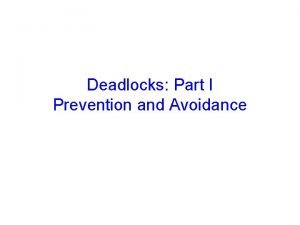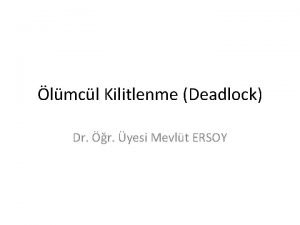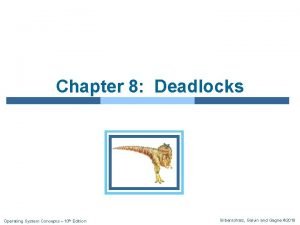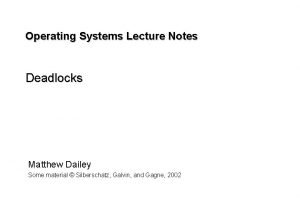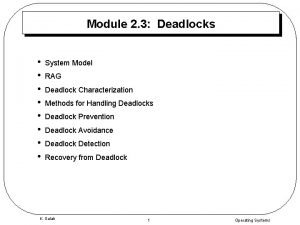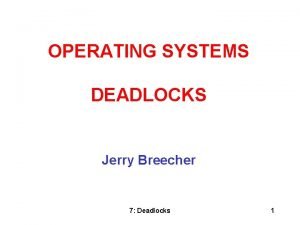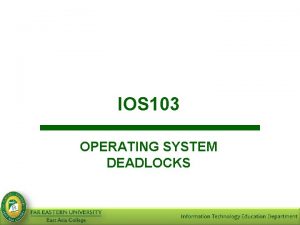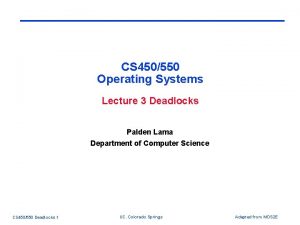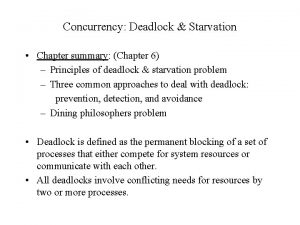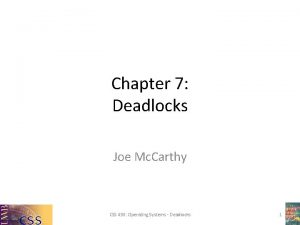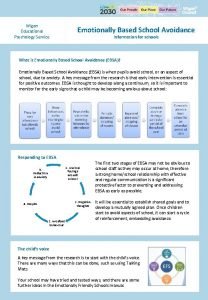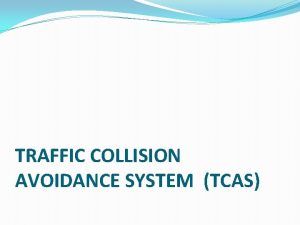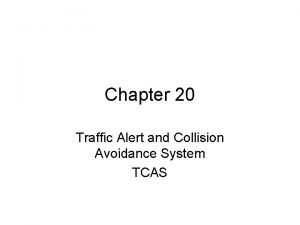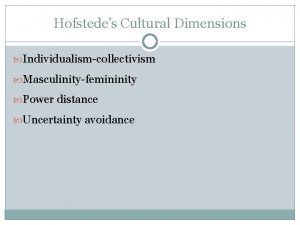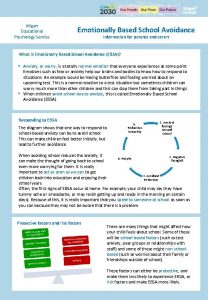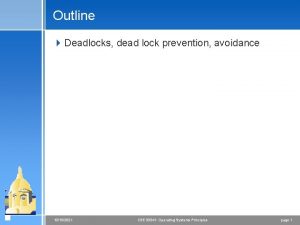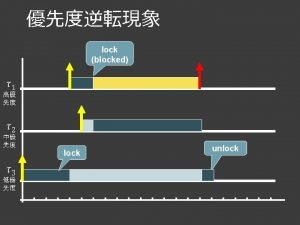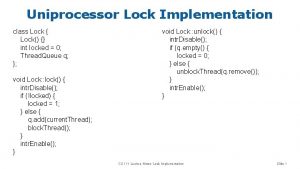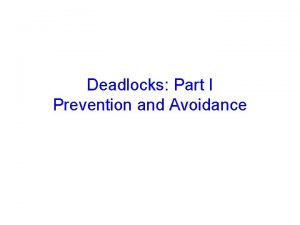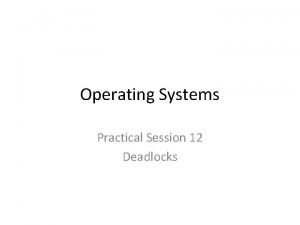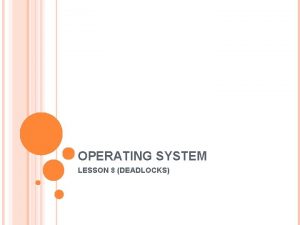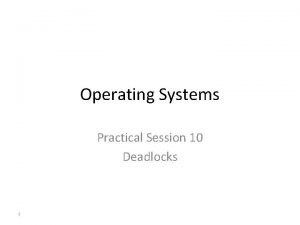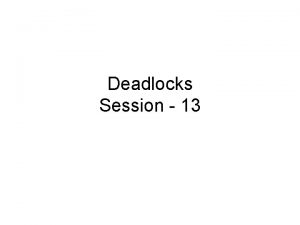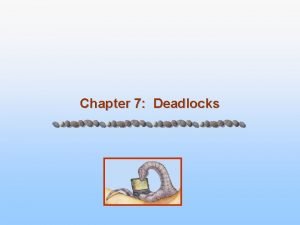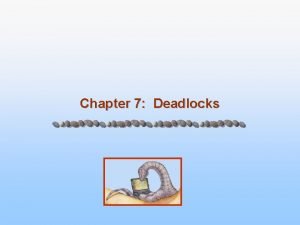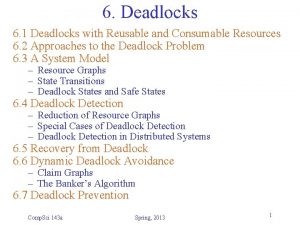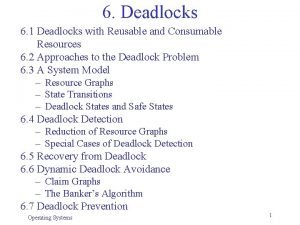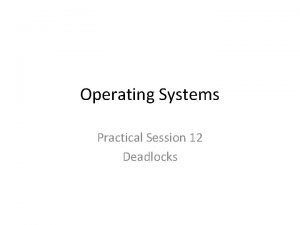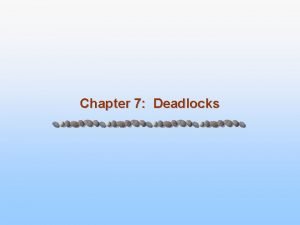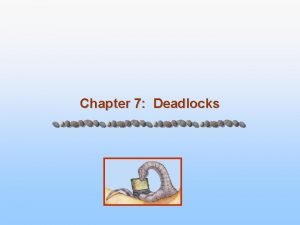Outline 4 Deadlocks dead lock prevention avoidance 11102020

































- Slides: 33

Outline 4 Deadlocks, dead lock prevention, avoidance 11/10/2020 CSE 30341: Operating Systems Principles page 1

Resource-Allocation Graph A set of vertices V and a set of edges E. 4 V is partitioned into two types: < P = {P 1, P 2, …, Pn}, the set consisting of all the processes in the system. < R = {R 1, R 2, …, Rm}, the set consisting of all resource types in the system. 4 request edge – directed edge P 1 Rj 4 assignment edge – directed edge Rj Pi 11/10/2020 CSE 30341: Operating Systems Principles page 2

Example of a Resource Allocation Graph 11/10/2020 CSE 30341: Operating Systems Principles page 3

Resource Allocation Graph With A Deadlock 11/10/2020 CSE 30341: Operating Systems Principles page 4

Resource Allocation Graph With A Cycle But No Deadlock 11/10/2020 CSE 30341: Operating Systems Principles page 5

Basic Facts 4 If graph contains no cycles no deadlock. 4 If graph contains a cycle < if only one instance per resource type, then deadlock. < if several instances per resource type, possibility of deadlock. 11/10/2020 CSE 30341: Operating Systems Principles page 6

Methods for Handling Deadlocks 4 Ensure that the system will never enter a deadlock state. 4 Allow the system to enter a deadlock state and then recover. 4 Ignore the problem and pretend that deadlocks never occur in the system; used by most operating systems, including UNIX. 11/10/2020 CSE 30341: Operating Systems Principles page 7

Deadlock Prevention Restrain the ways request can be made. 4 Mutual Exclusion – not required for sharable resources; must hold for nonsharable resources. 4 Hold and Wait – must guarantee that whenever a process requests a resource, it does not hold any other resources. < Require process to request and be allocated all its resources before it begins execution, or allow process to request resources only when the process has none. < Low resource utilization; starvation possible. 11/10/2020 CSE 30341: Operating Systems Principles page 8

Deadlock Prevention (Cont. ) 4 No Preemption – < If a process that is holding some resources requests another resource that cannot be immediately allocated to it, then all resources currently being held are released < Preempted resources are added to the list of resources for which the process is waiting < Process will be restarted only when it can regain its old resources, as well as the new ones that it is requesting 4 Circular Wait – impose a total ordering of all resource types, and require that each process requests resources in an increasing order of enumeration 11/10/2020 CSE 30341: Operating Systems Principles page 9

Deadlock Avoidance Requires that the system has some additional a priori information available. 4 Simplest and most useful model requires that each process declare the maximum number of resources of each type that it may need 4 The deadlock-avoidance algorithm dynamically examines the resource-allocation state to ensure that there can never be a circular-wait condition 4 Resource-allocation state is defined by the number of available and allocated resources, and the maximum demands of the processes 11/10/2020 CSE 30341: Operating Systems Principles page 10

Safe State 4 When a process requests an available resource, system must decide if immediate allocation leaves the system in a safe state 4 System is in safe state if there exists a safe sequence of all processes 4 Sequence <P 1, P 2, …, Pn> is safe if for each Pi, the resources that Pi can still request can be satisfied by currently available resources + resources held by all the Pj, with j<I < If Pi resource needs are not immediately available, then Pi can wait until all Pj have finished < When Pj is finished, Pi can obtain needed resources, execute, return allocated resources, and terminate < When Pi terminates, Pi+1 can obtain its needed resources, and so on 11/10/2020 CSE 30341: Operating Systems Principles page 11

Basic Facts 4 If a system is in safe state no deadlocks 4 If a system is in unsafe state possibility of deadlock 4 Avoidance ensure that a system will never enter an unsafe state 11/10/2020 CSE 30341: Operating Systems Principles page 12

Safe, Unsafe , Deadlock State 11/10/2020 CSE 30341: Operating Systems Principles page 13

Resource-Allocation Graph Algorithm 4 Claim edge Pi Rj indicated that process Pj may request resource Rj; represented by a dashed line. 4 Claim edge converts to request edge when a process requests a resource. 4 When a resource is released by a process, assignment edge reconverts to a claim edge. 4 Resources must be claimed a priori in the system. 11/10/2020 CSE 30341: Operating Systems Principles page 14

Resource-Allocation Graph For Deadlock Avoidance 11/10/2020 CSE 30341: Operating Systems Principles page 15

Unsafe State In Resource-Allocation Graph 11/10/2020 CSE 30341: Operating Systems Principles page 16

Banker’s Algorithm 4 Multiple instances. 4 Each process must a priori claim maximum use. 4 When a process requests a resource it may have to wait. 4 When a process gets all its resources it must return them in a finite amount of time 11/10/2020 CSE 30341: Operating Systems Principles page 17

Data Structures for the Banker’s Algorithm Let n = number of processes, and m = number of resources types 4 Available: Vector of length m. If available [j] = k, there are k instances of resource type Rj available. 4 Max: n x m matrix. If Max [i, j] = k, then process Pi may request at most k instances of resource type Rj. 4 Allocation: n x m matrix. If Allocation[i, j] = k then Pi is currently allocated k instances of Rj. 4 Need: n x m matrix. If Need[i, j] = k, then Pi may need k more instances of Rj to complete its task. Need [i, j] = Max[i, j] – Allocation [i, j]. 11/10/2020 CSE 30341: Operating Systems Principles page 18

Safety Algorithm 1. Let Work and Finish be vectors of length m and n, respectively. Initialize: Work = Available Finish [i] = false for i = 0, 1, …, n-1 2. Find an i such that both: (a) Finish [i] = false (b) Needi Work If no such i exists, go to step 4. 3. Work = Work + Allocationi Finish[i] = true go to step 2. 4. If Finish [i] == true for all i, then the system is in a safe state. 11/10/2020 CSE 30341: Operating Systems Principles page 19

Resource-Request Algorithm for Process Pi Request = request vector for process Pi. If Requesti [j] = k then process Pi wants k instances of resource type Rj. 1. If Requesti Needi go to step 2. Otherwise, raise error condition, since process has exceeded its maximum claim. 2. If Requesti Available, go to step 3. Otherwise Pi must wait, since resources are not available. 3. Pretend to allocate requested resources to Pi by modifying the state as follows: Available = Requesti; Allocationi = Allocationi + Requesti; Needi = Needi – Requesti; If safe the resources are allocated to Pi. l If unsafe Pi must wait, and the old resource-allocation state is restored l 11/10/2020 CSE 30341: Operating Systems Principles page 20

Example of Banker’s Algorithm 4 5 processes P 0 through P 4; 3 resource types A (10 instances), B (5 instances, and C (7 instances) 4 Snapshot at time T 0: Allocation Max Available ABC ABC P 0 0 1 0 753 332 P 1 2 0 0 322 P 2 3 0 2 902 P 3 2 1 1 222 P 4 0 0 2 4 3 3 11/10/2020 CSE 30341: Operating Systems Principles page 21

Example (Cont. ) 4 The content of the matrix. Need is defined to be Max – Allocation. Need ABC P 0 743 P 1 122 P 2 600 P 3 011 P 4 431 4 The system is in a safe state since the sequence < P 1, P 3, P 4, P 2, P 0> satisfies safety criteria. 11/10/2020 CSE 30341: Operating Systems Principles page 22

Example P 1 Request (1, 0, 2) (Cont. ) 4 Check that Request Available (that is, (1, 0, 2) (3, 3, 2) true. Allocation Need Available ABC ABC P 0 010 743 230 P 1 302 020 P 2 301 600 P 3 211 011 P 4 002 431 4 Executing safety algorithm shows that sequence <P 1, P 3, P 4, P 0, P 2> satisfies safety requirement. 4 Can request for (3, 3, 0) by P 4 be granted? 4 Can request for (0, 2, 0) by P 0 be granted? 11/10/2020 CSE 30341: Operating Systems Principles page 23

Deadlock Detection 4 Allow system to enter deadlock state 4 Detection algorithm 4 Recovery scheme 11/10/2020 CSE 30341: Operating Systems Principles page 24

Single Instance of Each Resource Type 4 Maintain wait-for graph < Nodes are processes. < Pi Pj if Pi is waiting for Pj. 4 Periodically invoke an algorithm that searches for a cycle in the graph. 4 An algorithm to detect a cycle in a graph requires an order of n 2 operations, where n is the number of vertices in the graph. 11/10/2020 CSE 30341: Operating Systems Principles page 25

Resource-Allocation Graph and Wait-for Graph Resource-Allocation Graph 11/10/2020 Corresponding wait-for graph CSE 30341: Operating Systems Principles page 26

Several Instances of a Resource Type 4 Available: A vector of length m indicates the number of available resources of each type. 4 Allocation: An n x m matrix defines the number of resources of each type currently allocated to each process. 4 Request: An n x m matrix indicates the current request of each process. If Request [ij] = k, then process Pi is requesting k more instances of resource type. Rj. 11/10/2020 CSE 30341: Operating Systems Principles page 27

Detection Algorithm 1. Let Work and Finish be vectors of length m and n, respectively Initialize: (a) Work = Available (b) For i = 0, 1, …, n-1, if allocationi 0, then Finish[i] = false; otherwise, Finish[i] = true. 4 Find an index i such that both: (a) Finish[i] == false (b) Requesti Work If no such i exists, go to step 4. < Work = Work + Allocationi Finish[i] = true go to step 2 4 If Finish[i] == false, for some i, 1 i n, then the system is in deadlock state. Moreover, if Finish[i] == false, then Pi is deadlocked. 11/10/2020 CSE 30341: Operating Systems Principles page 28

Example of Detection Algorithm 4 Five processes P 0 through P 4; three resource types A (7 instances), B (2 instances), and C (6 instances). 4 Snapshot at time T 0: Allocation Request Available ABC ABC P 0 010 000 P 1 200 202 P 2 303 000 P 3 211 100 P 4 002 4 Sequence <P 0, P 2, P 3, P 1, P 4> will result in Finish[i] = true for all i 11/10/2020 CSE 30341: Operating Systems Principles page 29

Example (Cont. ) 4 P 2 requests an additional instance of type C. Request ABC P 0 000 P 1 201 P 2 001 P 3 100 P 4 002 4 State of system? < Can reclaim resources held by process P 0, but insufficient resources to fulfill other processes; requests. < Deadlock exists, consisting of processes P 1, P 2, P 3, and P 4. 11/10/2020 CSE 30341: Operating Systems Principles page 30

Detection-Algorithm Usage 4 When, and how often, to invoke depends on: < How often a deadlock is likely to occur? < How many processes will need to be rolled back? = one for each disjoint cycle 4 If detection algorithm is invoked arbitrarily, there may be many cycles in the resource graph and so we would not be able to tell which of the many deadlocked processes “caused” the deadlock. 11/10/2020 CSE 30341: Operating Systems Principles page 31

Recovery from Deadlock: Process Termination 4 Abort all deadlocked processes 4 Abort one process at a time until the deadlock cycle is eliminated 4 In which order should we choose to abort? < Priority of the process < How long process has computed, and how much longer to completion < Resources the process has used. < Resources process needs to complete. < How many processes will need to be terminated. < Is process interactive or batch? 11/10/2020 CSE 30341: Operating Systems Principles page 32

Recovery from Deadlock: Resource Preemption 4 Selecting a victim – minimize cost. 4 Rollback – return to some safe state, restart process for that state. 4 Starvation – same process may always be picked as victim, include number of rollback in cost factor. 11/10/2020 CSE 30341: Operating Systems Principles page 33
 Primary prevention secondary prevention tertiary prevention
Primary prevention secondary prevention tertiary prevention Deadlock prevention vs avoidance
Deadlock prevention vs avoidance Deadlock prevention or avoidance
Deadlock prevention or avoidance Deadlock detection prevention and avoidance
Deadlock detection prevention and avoidance Deadlock can be described more precisely by
Deadlock can be described more precisely by Deadlock in operating system notes
Deadlock in operating system notes Rag deadlock
Rag deadlock Resource allocation graph
Resource allocation graph Deadlocks can be described more precisely
Deadlocks can be described more precisely Coffman deadlock
Coffman deadlock Integrated deadlock strategy
Integrated deadlock strategy Deadlocks mc
Deadlocks mc Juan soriano la niña muerta; the dead girl; dead infant
Juan soriano la niña muerta; the dead girl; dead infant Hospital avoidance program
Hospital avoidance program Types of motivational conflict
Types of motivational conflict Multiple approach-avoidance conflict
Multiple approach-avoidance conflict Wigan educational psychology service
Wigan educational psychology service Tcas collision avoidance
Tcas collision avoidance Experiential avoidance
Experiential avoidance Risk response types
Risk response types Tcas range
Tcas range In an avoidance contingency:
In an avoidance contingency: Special emphasis areas
Special emphasis areas Outer directed culture
Outer directed culture Wake turbulence avoidance
Wake turbulence avoidance Spin avoidance
Spin avoidance Avoidance contingency
Avoidance contingency Language
Language Churn avoidance
Churn avoidance Pathological demand avoidance test
Pathological demand avoidance test Emotionally based school avoidance
Emotionally based school avoidance Laray m. barna (1997)
Laray m. barna (1997) Avoidance risk
Avoidance risk Quote sandwich example
Quote sandwich example

